A Comprehensive Exploration of Mandarin Oranges


Intro
Mandarin oranges, a beloved fruit with a rich array of attributes, are celebrated across the globe for their unique flavor and versatility. They hold significant cultural importance in many regions and are widely regarded for their health benefits. This article aims to provide a thorough exploration of mandarin oranges, covering their origins, cultivation practices, various types, nutritional content, culinary applications, and cultural relevance.
The allure of mandarin oranges is not just in their delightful taste but also in their role as symbols of prosperity and good fortune in many traditions. Understanding these facets helps deepen one's appreciation for this popular fruit.
Recipe Overview
Mandarin oranges can be enjoyed in numerous recipes, ranging from simple snacks to elaborate dishes. One popular dish that features mandarin oranges is a refreshing Mandarin Orange Salad. This vibrant salad pairs the citrus sweetness of mandarin oranges with crisp greens and a light vinaigrette, making it an ideal choice for various occasions.
This salad originates from Asian cuisine, where citrus fruits hold a prominent place in dishes, both for their flavor and aesthetic appeal. The cultural significance of this dish extends beyond its taste; it often represents freshness and health, aligning with traditional culinary principles.
Ingredients List
A typical Mandarin Orange Salad includes the following ingredients:
- Fresh mandarin oranges
- Mixed salad greens (such as spinach and arugula)
- Sliced almonds or walnuts
- Red onion, thinly sliced
- Feta cheese or goat cheese
- Olive oil
- Balsamic vinegar
- Salt and pepper to taste
Special ingredient notes
- Special Ingredients: While feta cheese is commonly used, goat cheese can offer a different creamy texture and tanginess.
- Sourcing Tips: When selecting mandarin oranges, choose those that are firm and heavy for their size. They should have a bright, glossy skin, indicating freshness. If fresh mandarin oranges are not available, canned versions in light syrup can be an acceptable alternative.
This exploration of mandarin oranges, through a culinary lens, emphasizes not only their flavor but also how they can enhance various dishes. The inclusion of mandarin oranges in recipes provides both a burst of flavor and a visual appeal, underscoring their significance in culinary arts.
Preface to Mandarin Oranges
Mandarin oranges, small citrus fruits renowned for their sweetness and easy-to-peel skin, hold a significant place in both culinary and cultural contexts. Understanding the finer aspects of mandarin oranges enriches one’s appreciation for this versatile fruit. This article aims to provide a comprehensive examination of mandarin oranges, covering botany, history, nutritional benefits, and their role in global cuisines.
Historical Context
The history of mandarin oranges stretches back thousands of years, primarily rooted in Southeast Asia. Initially cultivated in ancient China, these fruits were of great importance not just for consumption but also as symbols of good fortune. Historical records suggest that they were slowly brought to Japan and Korea through trade.
As time passed, mandarin oranges became widely popular in various regions, leading to their introduction to Europe in the early 19th century. The cultivation and development of different varieties also emerged as these fruits became more mainstream. Today, countries such as Spain, the United States, and Brazil are prominent players in mandarin orange production. The fruit has not only shaped dietary habits but also impacted economic activities in regions known for cultivation.
Botanical Classification
Mandarin oranges belong to the Rutaceae family, specifically classified under the Citrus reticulata species. This classification is crucial as it distinguishes mandarin oranges from other citrus fruits, such as lemons and limes.
Within the mandarin group, several varieties have emerged, each with unique characteristics. For example, Satsuma, Clementine, and tangerines all derive from this species but cater to varying tastes and uses. The genetic diversity within mandarin oranges contributes to their prevalence in both fresh consumption and culinary applications.
Understanding the botanical background provides insight into the fruit’s adaptability and its suitable growing conditions, influencing how these fruits are cultivated worldwide.
"The mandarin orange stands out due to its sweet flavor and ease of peeling, making it a favored choice for many."
This deep dive into the historical and botanical aspects sets the stage for further exploration of cultivation practices, nutritional value, and cultural significance of mandarin oranges.
Cultivation and Harvesting
Cultivation and harvesting of mandarin oranges are essential components of understanding this fruit's journey from grove to table. These processes not only influence the quality and flavor of the fruit but also affect its availability and economic viability. Proper cultivation practices are vital for sustaining both the health of the mandarin trees and the surrounding environment. The attention given to these aspects serves as a foundation for ensuring that mandarin oranges maintain their vibrant presence in global markets, catering to the tastes and preferences of food lovers.


Ideal Growing Conditions
Mandarin oranges thrive in specific growing conditions that optimize their development. Ideally, these trees require a subtropical to tropical climate with ample sunlight. Exposure to sunlight enhances the sweetness and aroma of the fruit. Soil quality is also crucial; well-drained sandy loam or clay soils that retain moisture but allow for good drainage are preferable.
The temperature range for optimal growth is between 15°C and 30°C. Extreme temperatures, below 5°C or above 35°C, can severely affect growth and fruit yield. Proper irrigation is important as well. Although mandarin orange trees are somewhat drought-resistant, they perform best with consistent moisture during the growing season.
"Understanding the ideal growing conditions is integral to producing high-quality mandarin oranges."
Furthermore, proper fertilization enhances nutrient availability, ensuring strong and healthy trees. Organic fertilizers, in particular, contribute beneficial microbes to the soil, supporting sustainable practices.
Techniques for Cultivation
Several cultivation techniques are essential for the successful growth of mandarin oranges. Planting density plays an important role. Adequate spacing between trees allows for better air circulation and sunlight penetration, which are critical for fruit quality. Depending on the variety, standard spacing may range from 3 to 6 meters.
Pruning is also a key technique. Regular pruning aids in shaping the tree and removes dead or diseased branches, promoting better air flow and sunlight exposure. This practice can enhance fruit production and improve overall tree health.
Pest and disease management is vital. Integrated pest management strategies, which use a combination of biological control, cultural practices, and chemical interventions when necessary, help maintain the health of the trees while minimizing environmental impact. Regular monitoring of pest populations and any symptoms of disease can prevent significant crop loss.
Lastly, harvesting requires careful attention to timing. Harvesting mandarin oranges too early or too late can affect flavor and shelf life. Generally, oranges are ready to be picked when they reach a rich orange color and are slightly soft to the touch.
In summary, understanding the cultivation and harvesting of mandarin oranges is crucial for quality production. Knowledge of ideal conditions and effective cultivation techniques shapes the future of this beloved fruit.
Varieties of Mandarin Oranges
Understanding the various types of mandarin oranges is essential in grasping the full scope of their culinary potential. Each variety possesses unique characteristics that can influence flavor, texture, and suitability for different dishes. Familiarity with these differences allows both chefs and home cooks to choose the right mandarin orange for specific recipes or snacks. Moreover, knowing the distinctions between types helps in recognizing which varieties are available in different seasons and regions, ensuring optimal freshness and taste.
Satsuma
Satsuma mandarin oranges are notable for their loose skin, making them incredibly easy to peel. They are predominantly seedless, a feature that enhances their appeal, especially for children. This variety originates from Japan and thrives in regions with mild winters. The flavor profile of Satsumas presents a lovely balance of sweetness and tartness, making them ideal for eating raw. Their juicy segments can be used in salads, desserts, or simply enjoyed on their own.
Nutritionally, Satsumas are rich in vitamin C and fiber, promoting health benefits that enhance the overall dietary value. Additionally, they offer a refreshing choice for lunchboxes or snacks. Importantly, their vibrant color and pleasant aroma are aesthetically pleasing, further enhancing their desirability.
Clementine
Clementine mandarin oranges are among the most popular types, widely recognized for their sweetness. These small, seedless fruits are typically hybrid between a willowleaf mandarin and a sweet orange. They are characterized by their bright orange color and glossy skin, which is easy to peel. Clementines are usually available in late autumn and winter, aligning perfectly with the holiday season when citrus fruits are in high demand.
Their sweetness and lack of seeds make Clementines an excellent choice for snacking. They can be enjoyed on their own or added to fruit salads, pastries, and desserts. The high vitamin C content in clementines contributes to immune health and overall well-being. Their accessibility and flavor enhance their position in grocery stores, where they are often packaged attractively for consumers looking for convenient snacks.
Tangerine
Tangerines are another variety of mandarin oranges that can vary widely in flavor and texture. They are generally smaller than other oranges and tend to have a deep orange skin that is somewhat textured. The taste ranges from sweet to slightly tart, providing versatile options for culinary uses. Tangerines can be easily segmented, making them suitable for salads, cooking, and garnish.
Each tangerine may also differ in seediness and juiciness based on its specific variety, such as the Honey tangerine or the Dancy tangerine. In culinary applications, they can add bright flavors to a range of dishes, from savory to sweet.
Overall, the diversity within the varieties of mandarin oranges expands not only the flavor profiles available to consumers but also the practicality of these fruits in various culinary traditions. Understanding each mandarin orange type can enhance one's appreciation and utilization in cooking.
Nutritional Profile
The nutritional profile of mandarin oranges is significant for understanding their role in a healthy diet. These fruits are celebrated not just for their sweet flavor and bright color, but also for their extensive health benefits. Packed with vitamins and minerals, they are a nutritious choice for consumers of all ages. Their low calorie count and high water content make them an excellent option for those seeking to maintain a healthy weight while still enjoying flavorful snacks.
Vitamins and Minerals


Mandarin oranges are rich in vitamins, particularly vitamin C. A single medium-sized mandarin provides about 40% of the recommended daily intake of this essential nutrient. Vitamin C is known for its role in supporting the immune system and promoting skin health by aiding collagen production.
Several other vitamins are present in smaller amounts, including:
- Vitamin A: Important for vision and immune function.
- B Vitamins: Including folate and riboflavin, these help in energy production and brain function.
Moreover, mandarin oranges contain essential minerals like potassium and magnesium. Potassium is vital for heart health and helps regulate blood pressure. Magnesium plays a role in muscle function and energy production.
Health Benefits
The health benefits of mandarin oranges extend beyond their vitamin and mineral content. They are a good source of dietary fiber, which aids in digestion and can help prevent constipation. The antioxidants found in mandarin oranges may contribute to the reduction of inflammation in the body. In particular, flavonoids are abundant and have been linked to various health benefits, including improved heart health.
Incorporating mandarin oranges into the diet may lead to:
- Enhanced immune response due to high vitamin C levels.
- Better skin health from antioxidants combatting oxidative stress.
- Weight management due to their low calorie count and high fiber content.
"Mandarins are not only delicious but they also carry numerous health attributes that support overall well-being."
Understanding the nutritional profile of mandarin oranges allows culinary enthusiasts to appreciate their value beyond just flavor. The combination of taste and health benefits solidifies their place in both kitchens and pantries.
Culinary Uses of Mandarin Oranges
Culinary usage of mandarin oranges is pivotal in appreciating their diverse applications in gastronomy. This section examines how this fruit finds its way into various dishes, beverages, and desserts. Understanding these uses is not only beneficial for culinary enthusiasts but also for anyone seeking to enhance their diet with flavorful and nutritious options. Mandarin oranges offer bright flavors and can elevate a dish or refresh an occasion. Their versatility makes them a popular choice among cooks and chefs alike.
Raw Consumption
Mandarin oranges are often enjoyed raw. Their natural sweetness and juicy texture appeal to a wide range of palates. Eating them fresh provides a simple and healthy snack option. They are perfect for on-the-go consumption, making them a convenient choice for busy individuals. The segmental structure of mandarin oranges also allows for easy peeling and portioning, which enhances their appeal, particularly among children and families.
Health-conscious individuals often incorporate fresh mandarin oranges into their diets due to their low calorie count and high vitamin C content. A typical serving offers about 37% of the daily recommended intake of vitamin C, which is essential for immune function and skin health.
In Cooking and Baking
In culinary practices, mandarin oranges can add complexity to various dishes. Their zest and juice are popular in marinades and dressings, providing a citrusy brightness that complements savory flavors. For instance, adding mandarin juice to salad dressings can enhance the flavor profile of fresh greens.
When it comes to baking, mandarin oranges can be infused into cakes and pastries. Their zest, when added into batters, can impart a refreshing flavor, making cakes more intriguing. Mandarin orange segments can be used in tarts or mixed into muffins, creating a delightful balance between sweetness and acidity.
Beverages and Juices
Mandarin oranges are widely utilized in beverages, thanks to their juicy nature. Freshly squeezed mandarin juice is a popular drink, especially in warmer climates. The bright flavor can be enjoyed on its own or as part of mixed beverages. For example, blending mandarin juice with sparkling water creates a refreshing soda alternative.
Moreover, mandarin oranges can be vital in cocktail recipes, where their juice serves as a mixer. Cocktails featuring mandarin juice can offer a sophisticated drink option for gatherings. > For instance, the use of mandarin in a classic mojito adds a unique twist while maintaining the refreshing essence of the original drink.
Cultural Significance
The cultural significance of mandarin oranges extends beyond their culinary appeal. They are woven into the fabric of various traditions and hold deep meanings in several cultures. The fruit's sweetness and bright color symbolize prosperity, happiness, and good fortune. Such associations have prompted their incorporation in rituals and festivities. Understanding these aspects invites appreciation for mandarin oranges not just as a food item but as cultural icons that reflect values and beliefs.
Symbolism in Various Cultures
In many East Asian cultures, mandarin oranges are more than just a snack. They are viewed as harbingers of good luck. In Chinese customs, for instance, their round shape and bright hue represent wealth and completeness. During the Lunar New Year, it is common to gift mandarin oranges as a symbol of wishing others happiness and prosperity in the coming year.
Similarly, in Japanese culture, mandarins hold significance during the New Year celebrations as well. The fruit is associated with the practice of decorating the home to welcome good fortune for the upcoming year.


- Good Luck: The fruit is synonymous with auspiciousness in many traditions.
- Gifts of Happiness: They are often exchanged among families and friends, reflecting care and goodwill.
- Color Symbolism: The bright orange color signifies warmth and joy.
Festivals Involving Mandarin Oranges
Mandarin oranges play essential roles in various festivals, serving both dietary and symbolic functions.
During the Lunar New Year, these fruits become a central part of celebrations. They are intricately placed in decorative bowls and often given as gifts. The practice extends to various parts of Asia, with each culture imbuing its rituals with unique flavors.
In some regions, festivals involve games and activities centered around mandarin oranges. For instance, in certain parts of China, competitions may include tossing oranges into baskets as a way to invite prosperity.
- Lunar New Year: A key event where mandarin oranges are featured prominently.
- Community Celebrations: Festivals often celebrate the harvest, encouraging community engagement.
- Local Variations: Different regions may have their unique ways of incorporating the fruit into festivals, adding layers of significance to its culture.
"Mandarin oranges are more than just fruit; they are symbols of joy and prosperity, deeply embedded in cultural rituals and celebrations."
In summation, the cultural significance of mandarin oranges is multifaceted. This fruit embodies meanings that extend far beyond nutrition and flavor. Its role in celebrations and its symbolism in various cultures enrich the understanding of its value. This knowledge enhances appreciation, allowing food lovers of all ages to connect more deeply with the mandarin orange.
Environmental Considerations
The environmental considerations surrounding mandarin orange cultivation are crucial. As the world confronts climate change and other ecological issues, understanding how agricultural practices impact the environment becomes essential. Cultivating mandarin oranges involves various techniques that must balance agricultural productivity with sustainability. This section discusses the sustainability practices utilized in growing mandarin oranges and examines the challenges faced in production.
Sustainability Practices in Cultivation
Sustainable cultivation practices focus on minimizing environmental impact while ensuring that mandarin oranges are produced efficiently. This involves methods like integrated pest management, where farmers use biological control instead of widespread pesticide use. This practice not only protects the mandarin trees but also preserves local ecosystems.
Another key practice is the application of drip irrigation, which conserves water. Mandarins require ample water for growth, yet excessive usage can deplete local water resources. Drip systems ensure that each tree receives the optimal amount of moisture without wastage.
Furthermore, using crop rotation helps maintain soil health. By alternating mandarin trees with other crops, farmers can reduce pest and disease prevalence while enhancing soil nutrients. These holistic methods contribute to a cycle of sustainability, helping reduce reliance on synthetic fertilizers and harmful chemicals.
"Sustainability isn't just a choice; it's a way of farming that respects the earth and its resources."
Challenges in Production
Despite the environmental efforts incorporated into mandarin orange cultivation, several challenges persist. One primary concern is climate variability. Weather patterns affect the timing and quality of harvests. A late frost, for example, can damage vulnerable blossoms, leading to decreased fruit yield.
Additionally, pest outbreaks remain a threat. While integrated pest management aids in controlling pests, sudden infestations can occur. This situation may force farmers back to using more traditional methods, which often include chemical pesticides that can harm the environment.
Finally, the market demand for organic mandarin oranges has increased. Producers must navigate the costs associated with certification and organic practices, which can be prohibitive for smaller farms. Balancing consumer expectations with practical agricultural practices presents its own set of difficulties.
Finale
The exploration of mandarin oranges reveals their significance beyond mere consumption. This section synthesizes essential insights about the fruit, its cultivation methods, varieties, and cultural relevance. Understanding these aspects fosters not only appreciation but also encourages responsible practices in their use and cultivation.
Summary of Key Insights
Mandarin oranges are not just a popular fruit; they represent a rich tapestry of history and culture. Some key insights include:
- Diversity of Varieties: Mandarins come in various types, like Satsuma, Clementine, and Tangerine.
- Nutritional Value: They are packed with vitamins, particularly Vitamin C, and beneficial minerals.
- Culinary Versatility: Their uses range from raw eating to incorporation in savory dishes and beverages.
- Cultural Significance: Many cultures celebrate mandarin oranges as symbols of prosperity and good fortune, particularly during festivals.
- Sustainability Challenges: Environmental factors such as climate change present challenges in the sustainability of mandarin cultivation.
"Mandarin oranges have transcended their role as a fruit, evolving into symbols of cultural practices and culinary innovation."
Future of Mandarin Oranges in Culinary Practices
The future of mandarin oranges in culinary practices looks promising, influenced by several factors:
- Health Trends: As health-conscious eating continues to rise, the demand for nutritious fruits like mandarin oranges is likely to increase.
- Innovation in Culinary Arts: Chefs are exploring creative uses for this fruit in modern cuisine, such as in gourmet desserts and craft cocktails.
- Global Trade: Expansion in global trade will likely make mandarins more accessible, allowing more cuisines to integrate their flavors.
- Sustainability Initiatives: Efforts aimed at sustainability in agriculture may influence how mandarin oranges are grown and marketed, which can positively impact their availability and usage.
In summary, mandarin oranges embody a wealth of history, nutrition, and culinary potential. Their future will depend on trends in health, culinary creativity, and sustainable practices.



